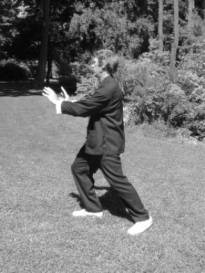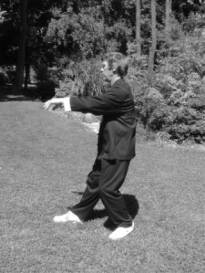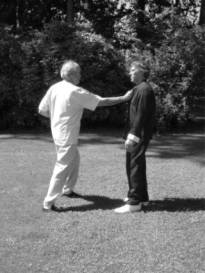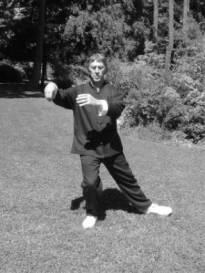 Gilman Studio On-Line Lessons
Gilman Studio On-Line Lessons
Yang Style Long Form
Tai Chi Chuan
This Lesson Contains:
Movement # 36 – Single Whip
This is the second of 10 variations of Single Whip. In this application, the opponent grabs me with his right hand. I use the hook hand to neutralize his grip and close him up to the right. I then step to his right side and deliver a slap with the back of my left hand while maintaining a pull with my right hook hand. This movement outward in two opposite directions is called Lieh Jing.

 The first part is the same for all the Single Whip variations that start with the end of Push. It is a transition back to the front and really doesn’t have a specific application.
The first part is the same for all the Single Whip variations that start with the end of Push. It is a transition back to the front and really doesn’t have a specific application.
Shift the weight straight back onto the left foot, and as you do, let the two hands relax until the palms face downward.
Be sure to come back into the left Kua. Do not lean back. Keep the elbows and shoulders drooped.
Focus on returning the energy to the Dan Tien.

 Continuing the turn to the front.
Continuing the turn to the front.
Once the weight is shifted to the left foot, turn the torso to the left until the center faces north. As you do this, the right foot pivots on the heel until the toe faces north. The arms follow the body, staying just to the sides of the chest. The right hand turns almost palm upward.
The first picture shows me continuing my movement into the forward position. The second picture shows John grabbing me. The first and second pictures do not follow each other in application. Sometimes the form is different than the practical application, or the application is not very important. In this case, the application starts when John grabs me.
Focus on the center.

 I make the hook hand and wrap around the opponent’s wrist.
I make the hook hand and wrap around the opponent’s wrist.
The only change at this point is the right hand forms a hook, with all the fingers touching the thumb, like you were holding something between your fingers.
This is an important point for what is to follow. If John lets go at this point, my reaction is different then if he holds his grip. Notice that he is closed up because I used my right hand to hook him. If I had used my left hand, I would have drawn his energy into me.
Focus on the right hook hand.
 This is a close up of the hook hand wrapping around the opponent’s wrist. Make sure to keep your right elbow well drooped and your shoulder relaxed. If John holds on fairly tightly, my hook hand, pressing on his wrist joint, will be painful. If I add pressure by pressing my body forward with a slight turn to the right, his wrist joint will be very painful. I can use this wristlock to take him to the ground by adding a bend down at the waist. If he lets go, he will be open to attack from my other hand, which is the case here.
This is a close up of the hook hand wrapping around the opponent’s wrist. Make sure to keep your right elbow well drooped and your shoulder relaxed. If John holds on fairly tightly, my hook hand, pressing on his wrist joint, will be painful. If I add pressure by pressing my body forward with a slight turn to the right, his wrist joint will be very painful. I can use this wristlock to take him to the ground by adding a bend down at the waist. If he lets go, he will be open to attack from my other hand, which is the case here.

 His grip is broken, and my leading his right arm to the right is closing him up.
His grip is broken, and my leading his right arm to the right is closing him up.
This is slightly tricky to describe with out being seen. As the hands move together to the right, the left foot opens and steps to face east. This is actually a very balanced step because the upper body is turning slightly to the right as the lower body steps to the left. It is like twisting a piece of cloth to wring out the water.
Be sure to step the left foot wide enough to the left side of the right foot to end up with a solid base of support. Do not let the arms open too much to the right or you will end up closing yourself up. Keep the Kua activated. Don’t shift any weight onto the left foot yet.
Focus on the right hook hand and the left foot for proper placement.

 I slap the opponent with the back of my left wrist, applying Lieh Jing (splitting energy).
I slap the opponent with the back of my left wrist, applying Lieh Jing (splitting energy).
The weight is shifted onto the left foot until the knee just covers the toe. At the same time, the torso is turned to the left until the center faces east.
The right hook hand stays in the same place (facing slightly to the right of north), while the left hand moves with the body to end up in line with the left leg. Keep the elbows and shoulders drooped.
You will notice in the pictures that in the application my body is facing a slightly different direction. Sometimes the form and application are different in order to make the form harmonious.
Focus on the back of the left hand and the right hook hand. You must balance the two opposite directions of energy flow.
